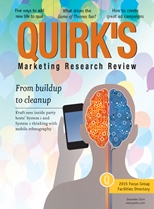This issue's keywords: social media; cannabis industry; wearables; loyalty; health care
Two million Mexicans are using social media to discuss their television programs, according to a study from SocialDecode, a division of Mexico City researcher the De La Riva Group. The new study of “Social TV” in Mexico, denoting television watchers who simultaneously use social networks to comment on programs or look at information, found that 60 percent of young adults are using social media as they watch and 67 percent visit Web sites advertised on TV.
A study by Canna Ventures, a Las Vegas marketing agency specializing in the cannabis industry, found that only 22 percent of respondents said that they were at least “somewhat likely” to use cannabis products if they were legal in their state, with other groups not supporting cannabis brands. Eric Layland, a co-founder of Canna Ventures, reported that marketers need to avoid using past “stoner” stereotypes and instead show respect to consumers with sophisticated messaging.
A new report by Allied Market Research, Portland, Ore., predicts that the global wearable electronics market will reach $25.19 billion by 2020. Allied Market says that the growth is due to the rising number of customers with digital services, the availability of wireless connectivity and the growth of technology, with wearable gadgets formerly used in industrial and commercial settings now moving into healthcare, sports and fitness and lifestyle applications. The market for lifestyle and fitness, which currently holds 38 percent of the overall market, is anticipated to have the highest growth.
Online banking, either online or by e-mail, is the predominant method of banking (49 percent), while 38 percent of business is conducted at a branch, according to a survey of 500 U.S. consumers regarding their experience with banks, relative loyalty and banking methods by NGDATA, a customer experience software firm in Ghent, Belgium. The respondents ranked customer services as most important (42 percent), with bank locations (24 percent), efficient online services (22 percent) and financial or loan rates (12 percent) following. Nearly half of the respondents (47 percent) say they are not very loyal to their bank and only 20 percent are “very confident” their bank understands them.
A survey of 700 physicians from mainland China, Hong Kong and Taiwan by Ruder Finn, a New York public relations firm, and Paris research company Ipsos found that 79 percent of Hong Kong physicians utilized digital channels to find medical information, such as side effects of drugs or clinical studies. Drug Web sites were preferred by 38 percent and e-newsletters by 33 percent. However, doctors still have concerns about creditability of online resources (50 percent) and potential bias (34 percent).
These reports were compiled from recent issues of the Daily News Queue, a free e-newsletter digest of marketing research and insights news and information delivered each business morning. Not already in the Queue? Sign up here!
